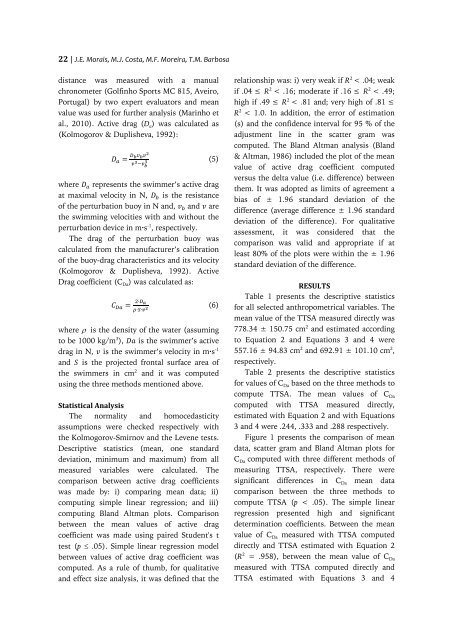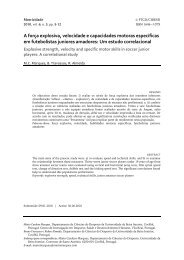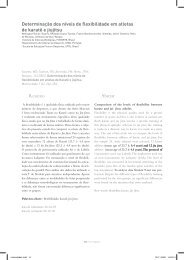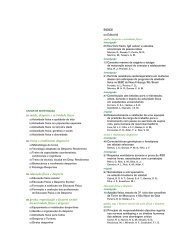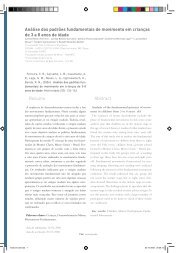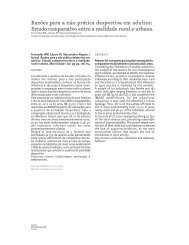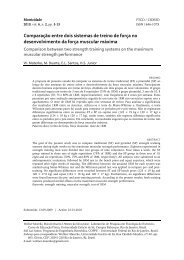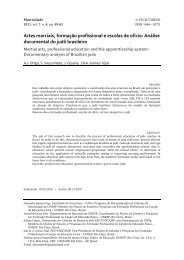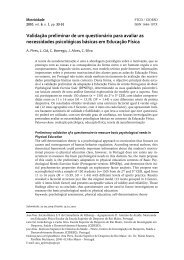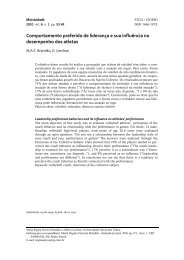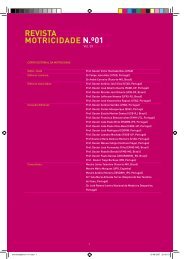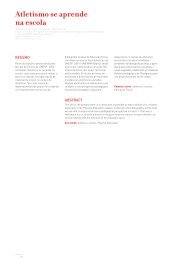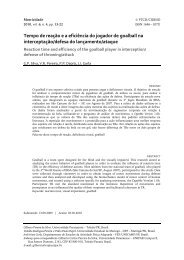revista motricidade
revista motricidade
revista motricidade
- No tags were found...
Create successful ePaper yourself
Turn your PDF publications into a flip-book with our unique Google optimized e-Paper software.
22 | J.E. Morais, M.J. Costa, M.F. Moreira, T.M. Barbosa<br />
distance was measured with a manual<br />
chronometer (Golfinho Sports MC 815, Aveiro,<br />
Portugal) by two expert evaluators and mean<br />
value was used for further analysis (Marinho et<br />
al., 2010). Active drag (D a ) was calculated as<br />
(Kolmogorov & Duplisheva, 1992):<br />
D a = D bv b v 2<br />
v 3 −v b<br />
3 (5)<br />
where D a represents the swimmer’s active drag<br />
at maximal velocity in N, D b is the resistance<br />
of the perturbation buoy in N and, v b and v are<br />
the swimming velocities with and without the<br />
perturbation device in m·s -1 , respectively.<br />
The drag of the perturbation buoy was<br />
calculated from the manufacturer’s calibration<br />
of the buoy-drag characteristics and its velocity<br />
(Kolmogorov & Duplisheva, 1992). Active<br />
Drag coefficient (C Da ) was calculated as:<br />
C Da = 2∙D a<br />
ρ∙S∙v 2 (6)<br />
where ρ is the density of the water (assuming<br />
to be 1000 kg/m 3 ), Da is the swimmer’s active<br />
drag in N, v is the swimmer’s velocity in m·s -1<br />
and S is the projected frontal surface area of<br />
the swimmers in cm 2 and it was computed<br />
using the three methods mentioned above.<br />
Statistical Analysis<br />
The normality and homocedasticity<br />
assumptions were checked respectively with<br />
the Kolmogorov-Smirnov and the Levene tests.<br />
Descriptive statistics (mean, one standard<br />
deviation, minimum and maximum) from all<br />
measured variables were calculated. The<br />
comparison between active drag coefficients<br />
was made by: i) comparing mean data; ii)<br />
computing simple linear regression; and iii)<br />
computing Bland Altman plots. Comparison<br />
between the mean values of active drag<br />
coefficient was made using paired Student's t<br />
test (p ≤ .05). Simple linear regression model<br />
between values of active drag coefficient was<br />
computed. As a rule of thumb, for qualitative<br />
and effect size analysis, it was defined that the<br />
relationship was: i) very weak if R 2 < .04; weak<br />
if .04 ≤ R 2 < .16; moderate if .16 ≤ R 2 < .49;<br />
high if .49 ≤ R 2 < .81 and; very high of .81 ≤<br />
R 2 < 1.0. In addition, the error of estimation<br />
(s) and the confidence interval for 95 % of the<br />
adjustment line in the scatter gram was<br />
computed. The Bland Altman analysis (Bland<br />
& Altman, 1986) included the plot of the mean<br />
value of active drag coefficient computed<br />
versus the delta value (i.e. difference) between<br />
them. It was adopted as limits of agreement a<br />
bias of ± 1.96 standard deviation of the<br />
difference (average difference ± 1.96 standard<br />
deviation of the difference). For qualitative<br />
assessment, it was considered that the<br />
comparison was valid and appropriate if at<br />
least 80% of the plots were within the ± 1.96<br />
standard deviation of the difference.<br />
RESULTS<br />
Table 1 presents the descriptive statistics<br />
for all selected anthropometrical variables. The<br />
mean value of the TTSA measured directly was<br />
778.34 ± 150.75 cm 2 and estimated according<br />
to Equation 2 and Equations 3 and 4 were<br />
557.16 ± 94.83 cm 2 and 692.91 ± 101.10 cm 2 ,<br />
respectively.<br />
Table 2 presents the descriptive statistics<br />
for values of C Da based on the three methods to<br />
compute TTSA. The mean values of C Da<br />
computed with TTSA measured directly,<br />
estimated with Equation 2 and with Equations<br />
3 and 4 were .244, .333 and .288 respectively.<br />
Figure 1 presents the comparison of mean<br />
data, scatter gram and Bland Altman plots for<br />
C Da computed with three different methods of<br />
measuring TTSA, respectively. There were<br />
significant differences in C Da mean data<br />
comparison between the three methods to<br />
compute TTSA (p < .05). The simple linear<br />
regression presented high and significant<br />
determination coefficients. Between the mean<br />
value of C Da measured with TTSA computed<br />
directly and TTSA estimated with Equation 2<br />
(R 2 = .958), between the mean value of C Da<br />
measured with TTSA computed directly and<br />
TTSA estimated with Equations 3 and 4


